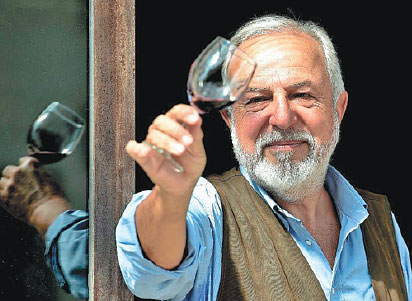Can prosecco help Italy unlock China wine market?
(China Daily) Updated: 2017-04-21 07:11|
Italian wine makers have yet to make big inroads into the booming Chinese market. Tiziana Fabi / Agence France-Presse |
VERONA, Italy-On paper it seems as obvious a pairing as a glass of spicy gewurztraminer with crispy duck and pancakes.
Yet Italy, the world's biggest wine producer, is lagging in the fight for sales in China, tipped to become the world's second biggest importer of wine by 2020.
Sales of chianti, pinot grigio and other samples from Italy's 300-plus wine denominations accounted for barely 5 percent of the $2.4 billion worth of wine that the world's most populous nation imported in 2016.
Of that total, 44 percent by value was sourced from France. Australia, Chile and Spain are also ahead of Italy in seducing the palates of China's burgeoning middle class.
"It's a pity. Italian producers have been slow to get into the market," says Andrew Tan, a Brunello di Montalcino enthusiast in charge of procurement for 1919, one of China's biggest liquor retailers.
With a network of more than 1,000 stores and an online platform, 1919 sent Tan to the recent Vinitaly trade fair in Verona.
His mission: to find Italian wines capable of matching the success of popular Australian brands like Jacob's Creek and Yellow Tail in the entry-to-middle sections of the Chinese market.
Tan also sees potential for smaller Italian wineries at higher price points, and for Italy's top-end barolos, brunellos and amarones as fine-wine investors expand their horizons beyond Bordeaux and Burgundy.
Uphill battle
But first Italy has to find a way into homes where glasses are currently filled by beer or spirits.
The simple brands message is not easy to get across in a country of more than 300,000 wineries with an unrivalled diversity of grape varieties and styles of wine making.
"Everyone has to understand that nobody in China knows what Italian wines are," says Stevie Kim, the managing director of Vinitaly International.
Kim has made cracking the Chinese market a joint priority alongside retaining Italy's market-leading role in the United States, whose import market is currently twice the size of China's.
She says Italian producers can offer better value than rivals at every price point, but accepts it will take time to make gains in China.
"I am not worried about China producing more wine itself," she says.
"Look at what happened in the United States after California took off. It is very important that the Chinese start drinking lots and lots of wine. Only then will they go into other wines and that is when we have to be ready."
Suzanne Mustacich, the author of Thirsty Dragon, an award-winning account of Bordeaux's phenomenal success in China, says it will be an uphill struggle.
"Italy lacks the brand recognition and association with luxury, history and quality enjoyed by Bordeaux in China," she says. "And Bordeaux's success did not happen overnight, China was on their radar for a very long time."
Italy's gains in the US have been helped by success in restaurants, aided by the large Italian diaspora.
Strength in diversity
That's not an option in China, but food can still be Italy's way-in, says Marco Pizzoli, a Shanghai-based executive for Italian wine group GIV.
"The potential is clearly there because wine is a trendy product, especially with millennials," Pizzoli says.
"Compared to countries like Italy and France where we have consumption of more than 30 liters per head (per year), in China we are still around 1.2-1.5 liters."
Educating potential consumers is key, he argues. "Italian restaurants are important but we should try to work more with local restaurants, which is where there is really the big potential."
Matching the aromas and flavors of Chinese food to wine is notoriously difficult. In the West, experts frequently recommend aromatic, off-dry wines, such as gewurztraminer.
Yet in China, it is structured, dry and often tannic reds based on cabernet sauvignon that have captured the market - contributing to Australia, Bordeaux and Chile's success.
Like Pizzoli, he sees the Chinese joining the prosecco party going on in many mature wine markets.
"Bubbles are getting more popular and it is still on the low end. Prosecco is not too expensive to drink," he says.
And in the longer run, Italy's complex wine landscape could be an asset, says Pizzoli. "It is difficult in the beginning but later on, when people are looking for something different and special, then we could have an advantage."
Agence France-Presse
- 'Cooperation is complementary'
- Worldwide manhunt nets 50th fugitive
- China-Japan meet seeks cooperation
- Agency ensuring natural gas supply
- Global manhunt sees China catch its 50th fugitive
- Call for 'Red Boat Spirit' a noble goal, official says
- China 'open to world' of foreign talent
- Free trade studies agreed on as Li meets with Canadian PM Trudeau
- Emojis on austerity rules from top anti-graft authority go viral
- Xi: All aboard internet express












